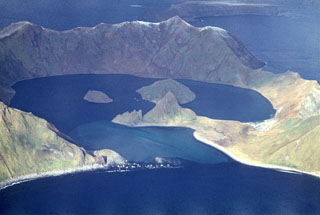Report on Ushishur (Russia) — March 1989
Scientific Event Alert Network Bulletin, vol. 14, no. 3 (March 1989)
Managing Editor: Lindsay McClelland.
Ushishur (Russia) Highly active fumaroles in the S part of the caldera
Please cite this report as:
Global Volcanism Program, 1989. Report on Ushishur (Russia) (McClelland, L., ed.). Scientific Event Alert Network Bulletin, 14:3. Smithsonian Institution. https://doi.org/10.5479/si.GVP.SEAN198903-290210
Ushishur
Russia
47.5125°N, 152.8139°E; summit elev. 357 m
All times are local (unless otherwise noted)
Two groups of highly active fumaroles were observed in the S part of the caldera during a 14 January aerial inspection. In autumn 1988, land observations showed solfataric activity, pressurized gas emission, and sulfur deposits within a 170 x 50 m area. Gas temperatures were 100-104°C.
Geological Summary. The subaerial portion of Ushishur volcano in the central Kuriles is exposed in two small islands, the southern containing the summit caldera and the northern a portion of the volcano's flanks. A small 1.6-km-wide caldera that formed about 9,400 years ago is narrowly breached on the south, allowing seawater to fill the caldera. Two andesitic lava domes occupy part of the caldera bay; two other older domes are joined by a sand bar to the SE caldera wall. The two younger domes, erupted sometime after the 1769 visit of Captain Snow, form islands in the bay. A cluster of strong fumaroles and hot springs are present along the SE caldera shoreline, and vigorous submarine hydrothermal activity has modified the geochemistry of water within the caldera bay. Aside from growth of the two younger lava domes, only minor phreatic eruptions have been recorded.
Information Contacts: G. Steinberg, Yuzhno-Sakhalinsk.

